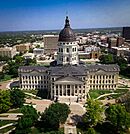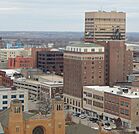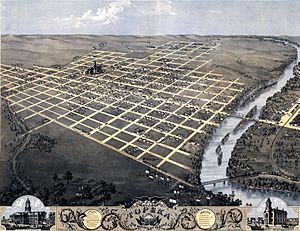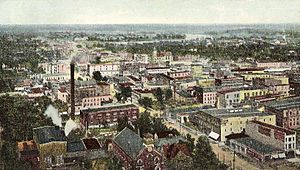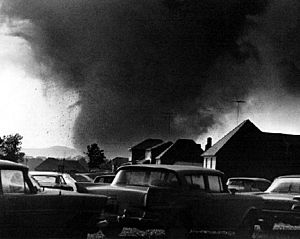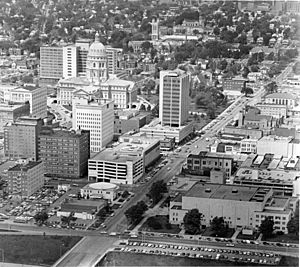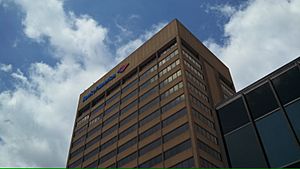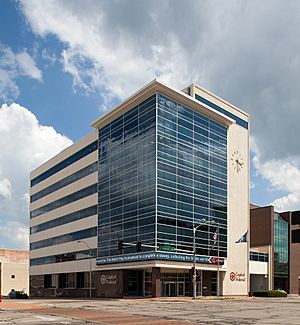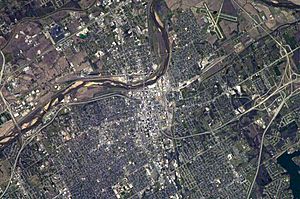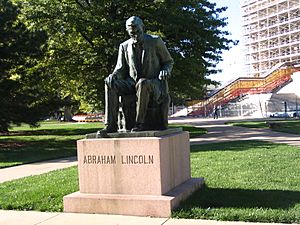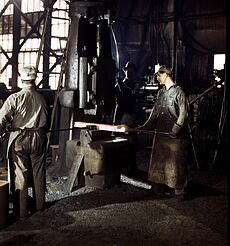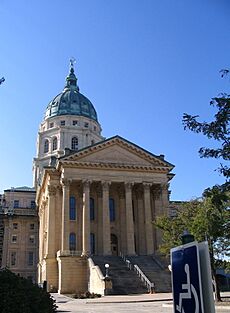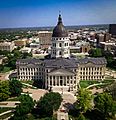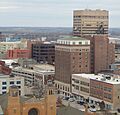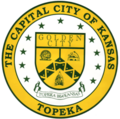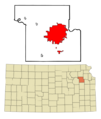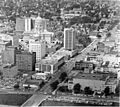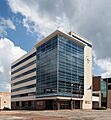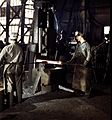Topeka, Kansas facts for kids
Quick facts for kids
Topeka, Kansas
|
|||
|---|---|---|---|
|
Downtown skyline from Burnett's Mound
Downtown Topeka
Kansas Attorney General
Topeka High School
|
|||
|
|||
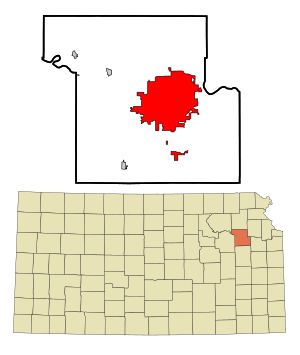
Location within Shawnee County and Kansas
|
|||
| Country | United States | ||
| State | Kansas | ||
| County | Shawnee | ||
| Founded | 1854 | ||
| Incorporated | 1857 | ||
| Government | |||
| • Type | Council–manager | ||
| Area | |||
| • State capital city | 62.76 sq mi (162.53 km2) | ||
| • Land | 61.44 sq mi (159.14 km2) | ||
| • Water | 1.31 sq mi (3.39 km2) | ||
| Elevation | 938 ft (286 m) | ||
| Population
(2020)
|
|||
| • State capital city | 126,587 | ||
| • Estimate
(2021)
|
125,963 | ||
| • Rank | US: 222nd KS: 5th |
||
| • Density | 2,017.00/sq mi (778.853/km2) | ||
| • Urban | 150,003 (US: 217th) | ||
| • Metro | 232,670 (US: 200th) | ||
| Demonym(s) | Topekan | ||
| Time zone | UTC−6 (CST) | ||
| • Summer (DST) | UTC−5 (CDT) | ||
| ZIP Codes |
66601–66612, 66614–66622, 66624–66626, 66636–66637, 66642, 66647, 66652–66653, 66667, 66675, 66683, 66692, 66699
|
||
| Area code | 785 | ||
| FIPS code | 20-71000 | ||
| GNIS ID | 485655 | ||
Topeka (pronounced tə-PEE-kə) is the capital city of Kansas, a state in the United States. It is also the main city of Shawnee County. Topeka is located along the Kansas River in the northeastern part of Kansas.
In 2020, about 126,587 people lived in Topeka. The larger Topeka area, which includes several nearby counties, had about 233,870 people in 2010.
The city was started in 1854 by people who were against slavery. This happened right after the Kansas–Nebraska Act was passed. Topeka officially became a city in 1857.
Topeka is famous for the important U.S. Supreme Court case, Brown v. Board of Education of Topeka. This case ruled that separating students by race in public schools was against the law. It changed an older ruling that allowed "separate but equal" schools.
Contents
History
Early Days
For thousands of years, the Great Plains of North America were home to Native American tribes. From the 1500s to the 1700s, France claimed large parts of North America. In 1762, France secretly gave New France to Spain after the French and Indian War.
In 1802, Spain gave most of this land back to France. Then, in 1803, the United States bought most of the land that is now Kansas from France. This was part of the huge Louisiana Purchase.
19th Century Growth
In the 1840s, wagon trains traveled west from Independence, Missouri, on the Oregon Trail. About 60 miles west of Kansas City, Missouri, three sisters who were part Kansas Indian and married to French-Canadian brothers started a ferry service. This ferry helped travelers cross the Kansas River where Topeka is now.
By the early 1850s, more people were traveling through the area. A new military road from Fort Leavenworth to Fort Riley passed through Topeka. In 1854, nine men formed the Topeka Town Association. One of them was Cyrus K. Holliday, who later became mayor and founded the Atchison, Topeka and Santa Fe Railway. Soon, steamboats regularly stopped in Topeka, bringing goods and taking farm products back east. By the late 1860s, Topeka was a busy trading center.
Topeka was a strong supporter of the "free-state" movement during the conflicts in Kansas Territory. This was a time when people argued fiercely about whether Kansas should allow slavery. In 1856, when pro-slavery forces blocked off Topeka, the town's leaders built defenses. They organized a militia and built earthwork walls with at least one cannon. These defenses helped protect the town until the blockade was lifted.
Kansas became the 34th state in the United States in 1861. This happened after ten years of conflict, which earned the territory the nickname "Bleeding Kansas". Topeka was chosen as the state capital, and Dr. Charles Robinson became the first governor.
In 1862, Cyrus K. Holliday gave land to the state for a new capitol building. Construction of the Kansas State Capitol began in 1866. It took 37 years to build, using Kansas limestone. In 1864, a fort called Fort Simple was built in downtown Topeka to protect against possible attacks during the American Civil War. It was taken down in 1867.
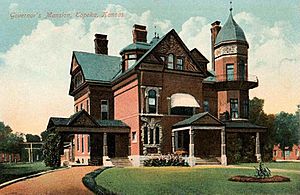
State officials first used the new capitol building in 1869. Before that, they worked in Constitution Hall. This hall was also where anti-slavery settlers met in 1855 to write one of the first state constitutions. The National Park Service recognizes Constitution Hall as a key site on the Underground Railroad, a secret network that helped enslaved people escape to freedom.
Even though a drought in 1860 and the American Civil War slowed growth, Topeka grew quickly after the war ended in 1865. In the 1870s, many former slaves, called Exodusters, settled in an area known as Tennessee Town. The first African American kindergarten west of the Mississippi River was started here in 1893.
Washburn University, originally called Lincoln College, was founded in Topeka in 1865. In 1869, the Atchison, Topeka & Santa Fe Railroad began expanding west from Topeka. The railroad's main offices and repair shops were built in the city in 1878.
In the late 1880s, Topeka experienced a rapid growth period that ended in a financial downturn. Many people lost money due to land speculation. However, Topeka's population doubled during this time, and the city managed to recover from the economic problems of the 1890s.
In the early 1900s, the automobile industry began to grow. The Smith Automobile Company was founded in Topeka in 1902, though it closed in 1912.
20th Century Events
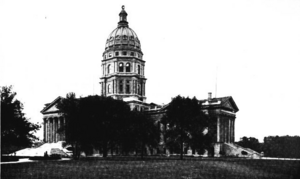
Topeka was home to Oliver Brown, the main person in the famous Brown v. Board of Education case. This case ended the idea of "separate but equal" schools and led to racial integration in American public schools. At the time, only elementary schools in Topeka were segregated. Topeka High School had been integrated since it opened in 1871.
Monroe Elementary, a segregated school involved in the Brown v. Board of Education decision, is now the Brown v. Board of Education National Historic Site. This site helps tell the story of the landmark case. President George W. Bush opened the National Historic Site on May 17, 2004.
Topeka has continued to work on issues of racial fairness even after the Brown decision. In the late 1980s, a group called the Task Force to Overcome Racism in Topeka was formed to address these challenges.
On June 8, 1966, Topeka was hit by a very powerful tornado. It started southwest of town and moved northeast, passing over Burnett's Mound. Some local Native American legends said this mound protected the city from tornadoes. The tornado caused $100 million in damage, making it one of the most expensive tornadoes in U.S. history at the time. The city recovered, and Washburn University, which lost several buildings, was rebuilt with community support.
In 1974, Forbes Air Force Base closed, and over 10,000 people left Topeka. This affected the city's growth for many years. In the 1980s, citizens voted to build a new airport and convention center. West Ridge Mall opened in 1988, replacing an older mall.
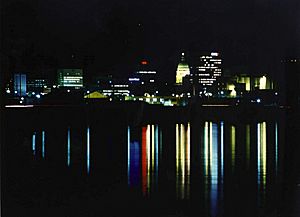
In 1989, Topeka became a center for motorsports with the opening of Heartland Park Topeka. The Topeka Performing Arts Center opened in 1991. In the early 1990s, businesses like Reser's Fine Foods, Santa Fe, and Hill's Pet Nutrition expanded in Topeka.
Throughout the 1990s, voters approved funding for school improvements, including new classrooms and technology. They also approved a sales tax for a new Law Enforcement Center and for road improvements. The Topeka & Shawnee County Public Library also expanded during this time.
21st Century Developments
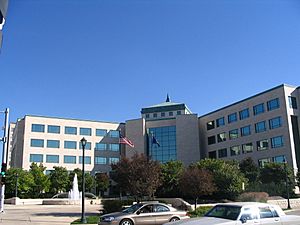
In 2000, citizens voted to continue a sales tax to help with economic development and improve roads and bridges. There are ongoing plans to redevelop areas along the Kansas River. Downtown Topeka has seen new apartments and improvements to its buildings and streets. On the other side of the river, Historic North Topeka has also been improved, and the Great Overland Station, a beautiful old railroad building, has been renovated. The State Capitol building is also undergoing a major renovation.
Google, Kansas
On March 1, 2010, Topeka's Mayor Bill Bunten made a fun announcement. For the month of March, he declared Topeka would be known as "Google, Kansas, the capital city of fiber optics." This was a way to show support for bringing Google Fiber to Topeka. It was not a legal name change, but a creative way to get attention.
Geography
Topeka is located in northeast Kansas. It is where I-70 and U.S. Highway 75 meet. I-335, which is part of the Kansas Turnpike, also starts here and goes south to Emporia, Kansas. Other major highways like U.S. Highway 24 and U.S. Highway 40 also pass through Topeka.
The city covers about 61.47 square miles (159.2 square kilometers). Most of this area is land, with a small portion being water.
Climate
Topeka has a climate that is a mix of humid continental and humid subtropical. This means it has hot, somewhat humid summers and cool to cold, fairly dry winters.
Temperatures change a lot throughout the year. The average daily temperature ranges from about 29.7°F (–1.3°C) in January to 79.0°F (26.1°C) in July. It gets above 90°F (32°C) about 41 days a year and above 100°F (38°C) about 3.5 days a year. Temperatures drop below 0°F (–18°C) about 4 nights a year.
Topeka gets about 36.5 inches (92.7 cm) of rain each year. The most rain falls in May and June. Thunderstorms are common in spring and summer, sometimes bringing lightning, large hail, and even tornadoes. Winter snowfall is usually light, averaging about 17.8 inches (45.2 cm) per year.
Demographics
| Historical population | |||
|---|---|---|---|
| Census | Pop. | %± | |
| 1860 | 759 | — | |
| 1870 | 5,790 | 662.8% | |
| 1880 | 15,452 | 166.9% | |
| 1890 | 31,007 | 100.7% | |
| 1900 | 33,608 | 8.4% | |
| 1910 | 43,684 | 30.0% | |
| 1920 | 50,022 | 14.5% | |
| 1930 | 64,120 | 28.2% | |
| 1940 | 67,833 | 5.8% | |
| 1950 | 78,791 | 16.2% | |
| 1960 | 119,484 | 51.6% | |
| 1970 | 125,011 | 4.6% | |
| 1980 | 115,266 | −7.8% | |
| 1990 | 119,883 | 4.0% | |
| 2000 | 122,377 | 2.1% | |
| 2010 | 127,473 | 4.2% | |
| 2020 | 126,587 | −0.7% | |
| 2023 (est.) | 125,475 | −1.6% | |
| U.S. Decennial Census 2010-2020 |
|||
Population Data
In 2020, Topeka had 126,587 people living in 54,092 households. The population density was about 2,060 people per square mile.
The city's population is made up of people from many different backgrounds. In 2020, about 64.18% of the population was White (not Hispanic). About 9.93% were Black or African American. About 16.39% of the population was Hispanic or Latino (who can be of any race).
About 22.7% of the people were under 18 years old. The average age in Topeka was 38.1 years. For every 100 females, there were about 91 males.
The average income for a household in Topeka was about $49,647 per year. About 13.9% of the population lived below the poverty line.
Religious Life
Topeka is known for its religious history. It was the site of Bethel Bible College, where Pentecostalism is said to have begun in 1901. It was also home to Reverend Charles Sheldon, who wrote the book In His Steps and asked the famous question, "What would Jesus do?"
The First Presbyterian Church in Topeka has a sanctuary decorated entirely with beautiful Tiffany stained glass. There are also many Roman Catholic churches, some with elementary schools. Grace Cathedral is a large, impressive Gothic-style church.
Topeka also has the oldest continuous Baháʼí community in Kansas, started in 1906.
The city is home to the Westboro Baptist Church, a group known for its protests. Across the street from them is the Equality House, a brightly painted rainbow house. It serves as a home for volunteers who support the LGBT+ community.
Economy
As the state capital, the biggest employer in Topeka is the State of Kansas. It employs about 8,400 people. This means government workers make up about one out of every five jobs in the city.
Many people also work in education, health, and social services. The four school districts employ nearly 4,700 people. Washburn University employs about 1,650 people. Large healthcare employers include Stormont-Vail HealthCare, St. Francis Health Center, and the VA Hospital.
Retail stores employ over 10% of the working population, with Wal-Mart and Dillons being major employers. Manufacturing also provides many jobs, with companies like Goodyear Tire and Rubber Company, Hill's Pet Nutrition, Frito-Lay, and Jostens Printing and Publishing.
Other industries include finance, insurance, real estate, and transportation. Blue Cross and Blue Shield of Kansas is a large insurance employer. BNSF is a major transportation employer, and Evergy provides electricity.
Top Employers
Here are some of the largest employers in Topeka as of 2023:
| # | Employer | Number of employees |
|---|---|---|
| 1 | State of Kansas | 9,919 |
| 2 | Stormont-Vail Health Care | 4,400 |
| 3 | Hill's Pet Nutrition | 3,439 |
| 4 | Topeka Unified School District 501 | 2,500 |
| 5 | Blue Cross Blue Shield of Kansas | 2,026 |
| 6 | BNSF Railway Company | 1,931 |
| 7 | Washburn University | 1,596 |
| 8 | Colmery-O'Neil VA Medical Center | 1,544 |
| 9 | University of Kansas Health System St. Francis Campus | 1,334 |
| 10 | Security Benefit Group of Companies | 1,000 |
Arts and Culture
Arts
The Topeka Symphony Orchestra was founded in 1957. Topeka also has many other places and groups that support fine art.
Points of Interest
- Brown v. Board of Education National Historic Site: Learn about the historic court case.
- Evel Knievel Museum: A museum dedicated to the famous daredevil.
- Kansas Children's Discovery Center: A fun place for kids in Gage Park.
- Kansas State Capitol: See the state's government building with special murals.
- Kansas Expocentre and Landon Arena: Places for events and concerts.
- Combat Air Museum: Located at Forbes Field, it displays military aircraft.
- Heartland Park Topeka: A major track for drag racing and road racing.
- Kansas Museum of History: Explore the history of Kansas.
- Reinisch Rose Garden and Doran Rock Garden: Beautiful gardens in Gage Park.
- Topeka High School: A historic high school building.
- Topeka & Shawnee County Public Library: A large public library.
- Topeka Zoo: Known for being the first zoo to have an indoor rain forest.
- Old Prairie Town at Ward-Meade Historic Site: A look back at early Kansas life.
- Washburn University: A university with a long history.
- Potwin Place Historic District: A historic neighborhood with its own traditions.
- Kansas Judicial Center: Where the state's highest courts meet.
- Cedar Crest: The Kansas Governor's Mansion.
- Great Overland Station: A renovated historic train station.
Sports
| Club | Sport | League |
|---|---|---|
| Topeka Warhawks | Baseball | Mid-Plains League |
| Topeka Tropics | Indoor American football | National Arena League |
Education
Schools for Kids and Teens
Topeka is served by four public school districts:
- Topeka USD 501 (serves the central part of Topeka)
- Shawnee Heights USD 450 (serves east and southeast Topeka)
- Auburn–Washburn USD 437 (serves west and southwest Topeka)
- Seaman USD 345 (serves North Topeka)
Colleges and Universities
Topeka has several colleges and universities for higher education:
- Washburn University
- Friends University (Topeka Campus)
- Washburn Institute of Technology
- Baker University School of Nursing (Topeka Campus)
- University of Kansas Health Center (St. Francis Campus)
- Rasmussen College (Topeka Campus)
Media
Topeka has a daily newspaper called the Topeka Capital-Journal. There are also other local newspapers like The Topeka Metro News.
Radio
Many radio stations broadcast from Topeka:
AM Stations
| Frequency | Callsign | Format | Notes |
|---|---|---|---|
| 580 | WIBW | News/Talk | |
| 1440 | KMAJ | News/Talk | |
| 1490 | KTOP | Sports |
FM Stations
| Frequency | Callsign | Format | Notes |
|---|---|---|---|
| 88.1 | KJTY | Contemporary Christian | |
| 89.5 | K208FE | Christian | Translator of KAWZ, Twin Falls, Idaho |
| 90.3 | KBUZ | Christian | AFR |
| 94.5 | WIBW-FM | Country | |
| 96.9 | KOZA | Hot Adult Contemporary | |
| 98.5 | KSAJ-FM | Adult hits | |
| 99.3 | KWIC | Classic hits | |
| 100.3 | KDVV | AOR | |
| 102.9 | KTOP-FM | Country | |
| 106.9 | KTPK | Classic country | |
| 107.7 | KMAJ | Adult contemporary |
Television
Several television stations are licensed to Topeka:
| Digital Channel | Analog Channel | Callsign | Network | Notes |
|---|---|---|---|---|
| 11 | 11 | KTWU | PBS | |
| 13 | 13 | WIBW-TV | CBS | |
| 25 | 26 | WROB-LD | Buzzr | |
| 27 | 27 | KSNT | NBC | |
| 33 | K33IC | TBN | ||
| 43 | 20 | KTMJ-CD | FOX | |
| 48; 49 (Virtual) | 49 | KTKA-TV | ABC |
Transportation
I-70, I-470, and I-335 all pass through Topeka. I-335 is part of the Kansas Turnpike. Other important highways include US-24, US-40, US-75, and K-4.
Topeka Regional Airport (FOE) is located south of Topeka. It also serves as an Air National Guard base. Philip Billard Municipal Airport (TOP) is another airport in Topeka. For major flights, people often use Kansas City International Airport (MCI).
Passenger train service is available through Amtrak at the Topeka Station. The train, called the Southwest Chief, travels between Chicago and Los Angeles. Greyhound Lines provides bus service to other cities.
The Topeka Metropolitan Transit Authority offers local bus service within the city.
Utilities
- Electricity: Evergy
- Home telephone: AT&T and Cox
- Cable: Cox Communications and AT&T
- Satellite TV: Dish and DirecTV
- Gas: Kansas Gas Service
- Water and sewer: City of Topeka
- Sanitation: Shawnee County Waste Management
- Internet: Cox (cable), AT&T (fiber, DSL, and fixed wireless), and other providers.
Notable People
Images for kids
See also
 In Spanish: Topeka para niños
In Spanish: Topeka para niños



